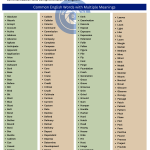Advertising is a crucial part of the business world, and effective advertising can help a company reach its target audience and drive sales. However, advertising can be complex and nuanced, and there are many terms and concepts that are specific to the industry.
In this blog, we’ll explore some essential advertising vocabulary that will help you understand the advertising world and improve your advertising efforts.
List of Advertising Vocabulary
Branding:
Branding is the process of creating a unique name, design, or symbol that identifies and differentiates a product or service from others in the marketplace.
Campaign:
A campaign is a series of coordinated advertising efforts that are designed to achieve a specific marketing goal, such as increasing sales or brand awareness.
Copy:
Copy refers to the text of an advertisement, including headlines, slogans, and body copy.
Creative:
Creative refers to the design and visuals of an advertisement, including the images, graphics, and layout.
Demographics:
Demographics refer to the characteristics of a specific group of people, such as age, gender, income, and education level. Understanding your target demographic is essential for effective advertising.
Impressions:
Impressions refer to the number of times an advertisement is viewed by a potential customer. This can include views on social media, website visits, and traditional media, such as television and radio.
Marketing:
Marketing is the process of promoting and selling products or services. It encompasses a range of activities, including market research, advertising, and branding.
Media:
Media refers to the channels through which advertising is distributed, including television, radio, print, and digital platforms.
Reach:
Reach refers to the total number of people who are exposed to an advertisement. This can include both unique views and repeat views.
Target audience:
The target audience is the specific group of people that an advertisement is designed to reach. Understanding your target audience is essential for creating effective advertising campaigns.
Call to action:
A call to action is a prompt that encourages the viewer to take a specific action, such as making a purchase, subscribing to a newsletter, or visiting a website.
Conversion:
Conversion refers to the act of a potential customer taking a desired action, such as making a purchase or signing up for a service, in response to an advertisement.
Frequency:
Frequency refers to the number of times a potential customer is exposed to an advertisement. High frequency can help increase the likelihood of conversion, but too much frequency can lead to viewer fatigue and decreased effectiveness.
ROI:
ROI stands for Return on Investment, and refers to the financial gains that a company receives from its advertising efforts.
Unique Selling Proposition:
The Unique Selling Proposition (USP) is the unique benefit or advantage that a product or service offers compared to its competitors. This is often highlighted in advertising to differentiate the product and make it more appealing to potential customers.
Advertising is a complex and nuanced field, but understanding these essential advertising vocabulary terms can help you communicate more effectively with advertising professionals, improve your advertising efforts, and achieve greater success in the business world.





